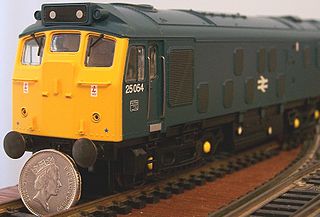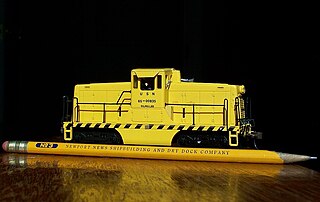
Railway modelling or model railroading is a hobby in which rail transport systems are modelled at a reduced scale.

OO gauge or OO scale is the most popular standard-gauge model railway standard in the United Kingdom despite being virtually unknown in other countries. This track gauge is one of several 4 mm-scale standards used, but it is the only one to be served by the major manufacturers. Unfortunately, the OO track gauge of 16.5 mm is actually incorrect for 4 mm scale, giving a track gauge equivalent of 4 ft 1½ in instead of 4 ft 8½ in. However, since the 1960s, other gauges in the same scale have arisen to reflect the desire of some modellers for greater scale accuracy.

A scale model is most generally a physical model of an object that maintains accurate relationships between its important aspects, although absolute values of the original properties need not be preserved. This enables it to demonstrate some behavior or property of the original object without examining the original object itself. The most familiar scale models represent the physical appearance of an object in miniature, but there are many other kinds.

O scale is a scale commonly used for toy trains and rail transport modelling. Introduced by German toy manufacturer Märklin around 1900, by the 1930s three-rail alternating current O gauge was the most common model railroad scale in the United States and remained so until the early 1960s. In Europe, its popularity declined before World War II due to the introduction of smaller scales.

HO or H0 is a rail transport modelling scale using a 1:87 scale. It is the most popular scale of model railway in the world. The rails are spaced 16.5 mm (0.650 in) apart for modelling 1,435 mm standard gauge tracks and trains in HO.

American Flyer is a brand of toy train and model railroad manufactured in the United States.

N scale is a popular model railway scale. Depending upon the manufacturer, the scale ranges from 1∶148 to 1∶160. In all cases, the gauge is 9 mm or 0.354 in. The term N gauge refers to the track dimensions, but in the United Kingdom in particular British N gauge refers to a 1∶148 scale with 1∶160 track gauge modelling. The terms N scale and N gauge are often inaccurately used interchangeably, as scale is defined as ratio or proportion of the model, and gauge only as a distance between rails. The scale 1∶148 defines the rail-to-rail gauge equal to 9 mm exactly, so when calculating the rail or track use 1∶160 and for engines and car wheel base use 1∶148.
Standard Gauge, also known as wide gauge, was an early model railway and toy train rail gauge, introduced in the United States in 1906 by Lionel Corporation. As it was a toy standard, rather than a scale modeling standard, the actual scale of Standard Gauge locomotives and rolling stock varied. It ran on three-rail track whose running rails were 2+1⁄8 in apart.
The Ives Manufacturing Company, an American toy manufacturer from 1868 to 1932, was the largest manufacturer of toy trains in the United States from 1910 until 1924, when Lionel Corporation overtook it in sales.

A toy train is a toy that represents a train. It is distinguished from a model train by an emphasis on low cost and durability, rather than scale modeling. A toy train can be as simple as a pull toy that does not even run on track, or it might be operated by clockwork or a battery. Many of today's model trains might be considered as toy ones as well, providing they are not strictly scale ones in favor of a robustness appropriate for children.
S scale is a model railroad scale modeled at 1:64 scale, S scale track gauge is 22,48 (22,5) mm, 0.885 in. S gauge trains are manufactured in both DC and AC powered varieties. S gauge is not to be confused with toy train standard gauge, a large-scale standard for toy trains in the early part of the 20th century.
Dorfan was an American toy company based in Newark, New Jersey from 1924 to 1934.

Carlisle & Finch is a manufacturer of nautical equipment founded in 1893 or 1894 in Cincinnati, Ohio, where, as of 2021, it still has its headquarters. The company's main products through its entire history have been searchlights, mostly for marine applications. It was also known for navigation beacons used by airports and lighthouses.
Hornby Railways is a British model railway brand. Its roots date back to 1901 in Liverpool, when founder Frank Hornby received a patent for his Meccano construction toy. The first clockwork train was produced in 1920. In 1938, Hornby launched its first 00 gauge train. In 1964, Hornby and Meccano were bought by their competitor, Tri-ang, and sold when Tri-ang went into receivership. Hornby Railways became independent again in the 1980s, and became listed on the London Stock Exchange, but due to financial troubles reported in June 2017, is presently majority owned by British turnaround specialist Phoenix Asset Management.

Bachmann Industries is a Bermuda registered Chinese owned company, globally headquartered in Hong Kong; specialising in model railroading.

Bing or Gebrüder Bing was a German toy company founded in 1863 in Nuremberg, Germany by two brothers, Ignaz Bing and Adolf Bing, originally producing metal kitchen utensils, but best remembered for its extensive lines of model trains and live steam engines. Ignaz is also known for his discovery and development of the Bing Cave, a show cave in Germany.
MTH Electric Trains, a privately held company based in Columbia, Maryland that is formerly known as Mike's Train House, is an American toy train and model railroad designer, importer, and manufacturer.

Voltamp was an early American manufacturer of toy trains based in Baltimore, Maryland. Founded by Manes Fuld (1863–1929), the son of a Baltimore stove dealer, Voltamp's trains utilized the same 2-inch gauge metal track as Carlisle & Finch, the inventor of the electric toy train. It is significant for its 1907 release of the first electric toy train that operated on household alternating current; earlier electric trains had used battery power.

Lionel Corporation was an American toy manufacturer and holding company of retailers that has been in business for over 120 years. It was founded as an electrical novelties company, Lionel specialized in various products throughout its existence. Toy trains and model railroads were its main claim to fame. Lionel also produced the diecast cars for NASCAR. Lionel trains have been produced since 1900, and their trains drew admiration from model railroaders around the world for the solidity of their construction and the authenticity of their detail. During its peak years in the 1950s, the company sold $25 million worth of trains per year. In 2006, Lionel's electric train became the first electric toy inducted into the National Toy Hall of Fame. In 1969, they sold their model train lines to General Mills, but continued to operate until 1993 as a holding company for their toy stores. Its model trains are still in production as a separate company.
1:64 scale is a traditional scale for models and miniatures, in which one unit on the model represents 64 units on the actual object. It is also known as "three-sixteenths scale", since 3/16 of an inch represents one foot. A human is approximately 1+1⁄16 inches (27 mm) tall in 1:64 scale. The scale originated by halving the very common 1:32 scale, which was known as "standard size" in some hobbies.












